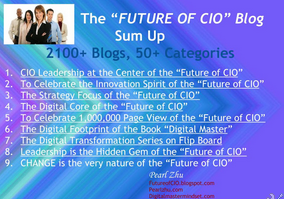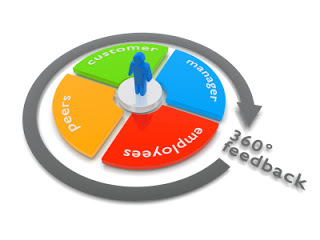Pearl Zhu's Blog, page 1404
September 19, 2015
How to Build a Customer-Centric Culture
When customer-centricity embedded in the culture, CX is not just the sequence of event, but the seamless continuum.
 Digital is the age of customers. Building customer centricity consistently in a way that delivers the right experiences to the right customers at the right times is, in most companies, enormously complicated. Changing the culture and breaking down silos is one of the biggest challenges. How to build a customer-centric culture and improve organizational maturity?
Digital is the age of customers. Building customer centricity consistently in a way that delivers the right experiences to the right customers at the right times is, in most companies, enormously complicated. Changing the culture and breaking down silos is one of the biggest challenges. How to build a customer-centric culture and improve organizational maturity?
CX needs to be part of the culture and needs to be sponsored by the C-Suite. As CX is so much about how an organization behaves, and not just what it delivers, the culture is key. Building a platform to communicate and engage all staff and channels with the vision is essential, and this vision must be joined up with other major change programs so that staff can see how it all fits together. With customer-centricity is well embedded into the corporate culture, CX needs to be delivered by the business, not a silo. There must be continuity and everyone must own it.
Culture is part passion, part commitment and part faith. It's the passion and excitement about what we're doing and how we're doing it. It's the synergy with the team, the managers and business leaders. The commitment is that we are all in this together and have our passions focused on a goal. We all succeed together or fail together. It's committing to each other to help, teach and share. Culture becomes the way we do business. It is our brand promise. If we promise our customers, we will be easy to do business with, and then internally we must become that to each other -- easy to work with and work for. Tools evolve into place at this point. If we promise our customers that we will be responsive, then our culture in the company needs to reflect that as well. If we promise our customers we will listen and take action, then internally we must act this way as well, and so on.
 Culture is a multi-pronged challenge and benefit. How your approach building it or changing it depends on several variables and dynamics. Culture has to be thought through for organizations that are larger and growing. The leadership needs to think about the values they want their employees to have, and be sure that not only the experience is good for the customers, but also good for employees. Guidelines like “on boarding,” mentors, and regular interactions with senior folks keep the "culture" of innovation and customer centricity alive. You need to hire, train and reinforce what you desire. It doesn’t happen organically without some vision and plan. Many business try to change "culture," become more "customer-centric" without building a solid foundation to empower people and the business to provide great customer experiences. CX is about culture, and culture is not about people - It IS people.
Culture is a multi-pronged challenge and benefit. How your approach building it or changing it depends on several variables and dynamics. Culture has to be thought through for organizations that are larger and growing. The leadership needs to think about the values they want their employees to have, and be sure that not only the experience is good for the customers, but also good for employees. Guidelines like “on boarding,” mentors, and regular interactions with senior folks keep the "culture" of innovation and customer centricity alive. You need to hire, train and reinforce what you desire. It doesn’t happen organically without some vision and plan. Many business try to change "culture," become more "customer-centric" without building a solid foundation to empower people and the business to provide great customer experiences. CX is about culture, and culture is not about people - It IS people.
Being customer-centric needs to be driven by a culture within the company starting at Board level. You need to believe that, the customer is the lifeline of the business. Once you have this basic premise right, everything flows naturally, exceptional customer service and WOW moments will be the automatic result, and then Customer Experience is not just the sequence of event, but the seamless continuum.
Follow us at: @Pearl_Zhu
 Digital is the age of customers. Building customer centricity consistently in a way that delivers the right experiences to the right customers at the right times is, in most companies, enormously complicated. Changing the culture and breaking down silos is one of the biggest challenges. How to build a customer-centric culture and improve organizational maturity?
Digital is the age of customers. Building customer centricity consistently in a way that delivers the right experiences to the right customers at the right times is, in most companies, enormously complicated. Changing the culture and breaking down silos is one of the biggest challenges. How to build a customer-centric culture and improve organizational maturity?
CX needs to be part of the culture and needs to be sponsored by the C-Suite. As CX is so much about how an organization behaves, and not just what it delivers, the culture is key. Building a platform to communicate and engage all staff and channels with the vision is essential, and this vision must be joined up with other major change programs so that staff can see how it all fits together. With customer-centricity is well embedded into the corporate culture, CX needs to be delivered by the business, not a silo. There must be continuity and everyone must own it.
Culture is part passion, part commitment and part faith. It's the passion and excitement about what we're doing and how we're doing it. It's the synergy with the team, the managers and business leaders. The commitment is that we are all in this together and have our passions focused on a goal. We all succeed together or fail together. It's committing to each other to help, teach and share. Culture becomes the way we do business. It is our brand promise. If we promise our customers, we will be easy to do business with, and then internally we must become that to each other -- easy to work with and work for. Tools evolve into place at this point. If we promise our customers that we will be responsive, then our culture in the company needs to reflect that as well. If we promise our customers we will listen and take action, then internally we must act this way as well, and so on.
 Culture is a multi-pronged challenge and benefit. How your approach building it or changing it depends on several variables and dynamics. Culture has to be thought through for organizations that are larger and growing. The leadership needs to think about the values they want their employees to have, and be sure that not only the experience is good for the customers, but also good for employees. Guidelines like “on boarding,” mentors, and regular interactions with senior folks keep the "culture" of innovation and customer centricity alive. You need to hire, train and reinforce what you desire. It doesn’t happen organically without some vision and plan. Many business try to change "culture," become more "customer-centric" without building a solid foundation to empower people and the business to provide great customer experiences. CX is about culture, and culture is not about people - It IS people.
Culture is a multi-pronged challenge and benefit. How your approach building it or changing it depends on several variables and dynamics. Culture has to be thought through for organizations that are larger and growing. The leadership needs to think about the values they want their employees to have, and be sure that not only the experience is good for the customers, but also good for employees. Guidelines like “on boarding,” mentors, and regular interactions with senior folks keep the "culture" of innovation and customer centricity alive. You need to hire, train and reinforce what you desire. It doesn’t happen organically without some vision and plan. Many business try to change "culture," become more "customer-centric" without building a solid foundation to empower people and the business to provide great customer experiences. CX is about culture, and culture is not about people - It IS people.
Being customer-centric needs to be driven by a culture within the company starting at Board level. You need to believe that, the customer is the lifeline of the business. Once you have this basic premise right, everything flows naturally, exceptional customer service and WOW moments will be the automatic result, and then Customer Experience is not just the sequence of event, but the seamless continuum.
Follow us at: @Pearl_Zhu
Published on September 19, 2015 23:53
What Drives you to be a Change Leader or an Agent
The drive of Change Leadership is for making progress and inspiring innovation.
 Change - big or small is inevitable. You can’t step into the same river twice, meaning that everything is always in a state of flow. However, as human beings we mostly want familiarity and stability. As a Change Manager or Change Agent: What’s your inspiration and motivation to lead changes? And how to manage it more effectively?
Change - big or small is inevitable. You can’t step into the same river twice, meaning that everything is always in a state of flow. However, as human beings we mostly want familiarity and stability. As a Change Manager or Change Agent: What’s your inspiration and motivation to lead changes? And how to manage it more effectively?
People are the very reason for the changes. Help talented people be successful and bring the wisdom to the workplace. Embracing change and making it integral to how we engage in the world is a river which you willingly step into and enjoy facilitating with others. There is no Organizational Design without change facilitation. Curiosity is the foundation of everything we do. Especially finding how to keep the process moving forward. It’s exciting to shift mind and bring about behavior change to achieve objectives which can truly make positive progress in either an organization or beyond. Leadership inspires the transition. It is what energizes people and sustain a change in behavior and approach. Leadership engages the hearts and minds of staff.
Help the organization become more successful and guide the employees better through the changes. Working with people who are looking to grow and improve their world through change and transformation. While moving to change, roles may initially have been serendipity. Leadership roles in HR, talent management or Change Management, are inevitably about engagement and driving change. Management plays an essential part in making the changes happen; it empowers the doing. Managers are taught to manage processes and resources effectively. Managing the change process and transmitting emotions is fundamental to the success of a change-oriented project. Many people are inherently cynical about change, many doubt there are effective means to accomplish major organizational change. Change requires the management of people’s anxiety and confusion or conversely stimulates their excitement and engagement. People fear what they don’t understand. People make assumptions based on their own experiences and perceptions. People naturally resist change. Nevertheless, at the outset of change you find innovators and early adopters. These individuals are critical in building the necessary guiding coalition and should be leveraged to gain the support of others. These are emotions most managers try to deal with or address.
 Enjoy the challenges about complex problem-solving. A change agent is a problem-solver, enjoy understanding the complexity and guide people through it; finding common ground and initiative dialogues. Turn around the tough situations. Change Management needs to be people-centric, shouldn’t just put emphasis on change tools. Unless you get the people side right even the most awesome plans and technical expertise still fall over! The implementation of any significant change process usually succeeds or fails because of the leadership of that change process. Leadership and management are two distinct and complementary systems of action. People issues are the primary obstacle to change, both on the leadership side and the follower side. On the leadership side, there are problems with the leader’s inability to lead, management’s inability to execute the strategy and ineffective leadership teams. On the follower side, often the problems are associated with the nature of the human being.
Enjoy the challenges about complex problem-solving. A change agent is a problem-solver, enjoy understanding the complexity and guide people through it; finding common ground and initiative dialogues. Turn around the tough situations. Change Management needs to be people-centric, shouldn’t just put emphasis on change tools. Unless you get the people side right even the most awesome plans and technical expertise still fall over! The implementation of any significant change process usually succeeds or fails because of the leadership of that change process. Leadership and management are two distinct and complementary systems of action. People issues are the primary obstacle to change, both on the leadership side and the follower side. On the leadership side, there are problems with the leader’s inability to lead, management’s inability to execute the strategy and ineffective leadership teams. On the follower side, often the problems are associated with the nature of the human being.
The speed of change is accelerating. Change is not for its own sake, the drive of Change Leadership is for making progress and inspiring innovation. Change needs to be people-centric, not process focused. Leading change starts from the mind shift. As a change leader or agent, managing change is no longer a one-time initiative, but an ongoing strategic capability, leading strategy is different from managing the operation. Therefore, you have to be learning agile and be a change agent yourself first, in order to lead change more effectively.
Follow us at: @Pearl_Zhu
 Change - big or small is inevitable. You can’t step into the same river twice, meaning that everything is always in a state of flow. However, as human beings we mostly want familiarity and stability. As a Change Manager or Change Agent: What’s your inspiration and motivation to lead changes? And how to manage it more effectively?
Change - big or small is inevitable. You can’t step into the same river twice, meaning that everything is always in a state of flow. However, as human beings we mostly want familiarity and stability. As a Change Manager or Change Agent: What’s your inspiration and motivation to lead changes? And how to manage it more effectively?
People are the very reason for the changes. Help talented people be successful and bring the wisdom to the workplace. Embracing change and making it integral to how we engage in the world is a river which you willingly step into and enjoy facilitating with others. There is no Organizational Design without change facilitation. Curiosity is the foundation of everything we do. Especially finding how to keep the process moving forward. It’s exciting to shift mind and bring about behavior change to achieve objectives which can truly make positive progress in either an organization or beyond. Leadership inspires the transition. It is what energizes people and sustain a change in behavior and approach. Leadership engages the hearts and minds of staff.
Help the organization become more successful and guide the employees better through the changes. Working with people who are looking to grow and improve their world through change and transformation. While moving to change, roles may initially have been serendipity. Leadership roles in HR, talent management or Change Management, are inevitably about engagement and driving change. Management plays an essential part in making the changes happen; it empowers the doing. Managers are taught to manage processes and resources effectively. Managing the change process and transmitting emotions is fundamental to the success of a change-oriented project. Many people are inherently cynical about change, many doubt there are effective means to accomplish major organizational change. Change requires the management of people’s anxiety and confusion or conversely stimulates their excitement and engagement. People fear what they don’t understand. People make assumptions based on their own experiences and perceptions. People naturally resist change. Nevertheless, at the outset of change you find innovators and early adopters. These individuals are critical in building the necessary guiding coalition and should be leveraged to gain the support of others. These are emotions most managers try to deal with or address.
 Enjoy the challenges about complex problem-solving. A change agent is a problem-solver, enjoy understanding the complexity and guide people through it; finding common ground and initiative dialogues. Turn around the tough situations. Change Management needs to be people-centric, shouldn’t just put emphasis on change tools. Unless you get the people side right even the most awesome plans and technical expertise still fall over! The implementation of any significant change process usually succeeds or fails because of the leadership of that change process. Leadership and management are two distinct and complementary systems of action. People issues are the primary obstacle to change, both on the leadership side and the follower side. On the leadership side, there are problems with the leader’s inability to lead, management’s inability to execute the strategy and ineffective leadership teams. On the follower side, often the problems are associated with the nature of the human being.
Enjoy the challenges about complex problem-solving. A change agent is a problem-solver, enjoy understanding the complexity and guide people through it; finding common ground and initiative dialogues. Turn around the tough situations. Change Management needs to be people-centric, shouldn’t just put emphasis on change tools. Unless you get the people side right even the most awesome plans and technical expertise still fall over! The implementation of any significant change process usually succeeds or fails because of the leadership of that change process. Leadership and management are two distinct and complementary systems of action. People issues are the primary obstacle to change, both on the leadership side and the follower side. On the leadership side, there are problems with the leader’s inability to lead, management’s inability to execute the strategy and ineffective leadership teams. On the follower side, often the problems are associated with the nature of the human being.
The speed of change is accelerating. Change is not for its own sake, the drive of Change Leadership is for making progress and inspiring innovation. Change needs to be people-centric, not process focused. Leading change starts from the mind shift. As a change leader or agent, managing change is no longer a one-time initiative, but an ongoing strategic capability, leading strategy is different from managing the operation. Therefore, you have to be learning agile and be a change agent yourself first, in order to lead change more effectively.
Follow us at: @Pearl_Zhu
Published on September 19, 2015 23:50
September 18, 2015
The Weekly Insight of the “Future of CIO”
The most critical and yet overlooked foundation to being a real leader is in choosing a destination that creates a better world!
 The “Future of CIO” Blog has reached 1.1 million page views with about #2150th blog posting in 50+ different categories of leadership, management, strategy, digitalization, change/talent, etc. blog posting. The content richness is not for its own sake, but to convey the vision and share the wisdom. Here is the weekly insight of the “Future of CIO” blog.
The “Future of CIO” Blog has reached 1.1 million page views with about #2150th blog posting in 50+ different categories of leadership, management, strategy, digitalization, change/talent, etc. blog posting. The content richness is not for its own sake, but to convey the vision and share the wisdom. Here is the weekly insight of the “Future of CIO” blog.
The Weekly Insight of the “Future of CIO” Blog
How to Define the Right People: “Hiring the right person to the right position at the right time,” is the mantra of many forward-thinking organizations. The question is how would you define the right people? The right mindset is utmost quality for being a right fit because the power of the mind is the force to change the business or even the world for better.The Quality of Experience: The better way to define experience is as “Lessons Learned.” Do you have X years experience or do you have ONE year experience X times? The pace of change is increasing, EXPERIENCE can no longer be measured quantitatively only, quality counts, dynamic counts, and learning agility counts - in mastering the full cycle of learning, de-learning and relearning. You just have to deepen the experience continually to capture the insight, or broaden your experiences to cultivate creativity or refine wisdom.Feedback - Constructive or Destructive: Nobody is perfect, we should always self-aware, accept feedback that is truthful and accurate, constructive with good intention. However, those who give negative feedback based on ignorance, misinformation, misjudgment, gossip, or even rumors, envy or revenge, earn the scorn and contempt. That being said, the QUALITY of feedback giver is crucial to the quality of feedback being given, the QUALITY is about the person’s reputation, cognition, character, integrity, insight, and intention., etc. The Systems Thinking Principles: Without the right set of System principles, the white can be taken as black, the round can be perceived as square, and the good can be translated into evil. It is utterly important that a basic understanding of what an integrative system is about. Are we here to play at a game of "Systems Thinking" with outdated and limited definitions and rules set several decades ago, or to apply the best understanding of how the system works to fix the great problems we face as systematically as we can? Systems Thinking Principles are the set of abstract and more “timeless” guidelines helping frame the questions in problem diagnosing and solving. The Sum Up of the “Future of CIO” Slideshare: The “Future of CIO” Blog has reached 1.1 million page views with #2150+ blog posting. Among 50+ different categories of leadership, management, strategy, digitalization, change/talent, etc. blog posting, Here are the NINE COREs of the “Future of CIO”! Blogging is not about writing, but about thinking and innovating the new ideas; it’s not just about WHAT to say, but about WHY to say, and HOW to say it. It reflects the color and shade of your thought patterns, and it indicates the peaks and curves of your thinking waves. Unlike pure entertainment, quality and professional content takes time for digesting, contemplation and engaging, and therefore, it takes time to attract the "hungry minds" and the "deep souls." It’s the journey to amplify diverse voices and deepen digital footprints, and it's the way to harness your innovative spirit.
Blogging is not about writing, but about thinking and innovating the new ideas; it’s not just about WHAT to say, but about WHY to say, and HOW to say it. It reflects the color and shade of your thought patterns, and it indicates the peaks and curves of your thinking waves. Unlike pure entertainment, quality and professional content takes time for digesting, contemplation and engaging, and therefore, it takes time to attract the "hungry minds" and the "deep souls." It’s the journey to amplify diverse voices and deepen digital footprints, and it's the way to harness your innovative spirit.
Follow us at: @Pearl_Zhu
 The “Future of CIO” Blog has reached 1.1 million page views with about #2150th blog posting in 50+ different categories of leadership, management, strategy, digitalization, change/talent, etc. blog posting. The content richness is not for its own sake, but to convey the vision and share the wisdom. Here is the weekly insight of the “Future of CIO” blog.
The “Future of CIO” Blog has reached 1.1 million page views with about #2150th blog posting in 50+ different categories of leadership, management, strategy, digitalization, change/talent, etc. blog posting. The content richness is not for its own sake, but to convey the vision and share the wisdom. Here is the weekly insight of the “Future of CIO” blog.The Weekly Insight of the “Future of CIO” Blog
How to Define the Right People: “Hiring the right person to the right position at the right time,” is the mantra of many forward-thinking organizations. The question is how would you define the right people? The right mindset is utmost quality for being a right fit because the power of the mind is the force to change the business or even the world for better.The Quality of Experience: The better way to define experience is as “Lessons Learned.” Do you have X years experience or do you have ONE year experience X times? The pace of change is increasing, EXPERIENCE can no longer be measured quantitatively only, quality counts, dynamic counts, and learning agility counts - in mastering the full cycle of learning, de-learning and relearning. You just have to deepen the experience continually to capture the insight, or broaden your experiences to cultivate creativity or refine wisdom.Feedback - Constructive or Destructive: Nobody is perfect, we should always self-aware, accept feedback that is truthful and accurate, constructive with good intention. However, those who give negative feedback based on ignorance, misinformation, misjudgment, gossip, or even rumors, envy or revenge, earn the scorn and contempt. That being said, the QUALITY of feedback giver is crucial to the quality of feedback being given, the QUALITY is about the person’s reputation, cognition, character, integrity, insight, and intention., etc. The Systems Thinking Principles: Without the right set of System principles, the white can be taken as black, the round can be perceived as square, and the good can be translated into evil. It is utterly important that a basic understanding of what an integrative system is about. Are we here to play at a game of "Systems Thinking" with outdated and limited definitions and rules set several decades ago, or to apply the best understanding of how the system works to fix the great problems we face as systematically as we can? Systems Thinking Principles are the set of abstract and more “timeless” guidelines helping frame the questions in problem diagnosing and solving. The Sum Up of the “Future of CIO” Slideshare: The “Future of CIO” Blog has reached 1.1 million page views with #2150+ blog posting. Among 50+ different categories of leadership, management, strategy, digitalization, change/talent, etc. blog posting, Here are the NINE COREs of the “Future of CIO”!
 Blogging is not about writing, but about thinking and innovating the new ideas; it’s not just about WHAT to say, but about WHY to say, and HOW to say it. It reflects the color and shade of your thought patterns, and it indicates the peaks and curves of your thinking waves. Unlike pure entertainment, quality and professional content takes time for digesting, contemplation and engaging, and therefore, it takes time to attract the "hungry minds" and the "deep souls." It’s the journey to amplify diverse voices and deepen digital footprints, and it's the way to harness your innovative spirit.
Blogging is not about writing, but about thinking and innovating the new ideas; it’s not just about WHAT to say, but about WHY to say, and HOW to say it. It reflects the color and shade of your thought patterns, and it indicates the peaks and curves of your thinking waves. Unlike pure entertainment, quality and professional content takes time for digesting, contemplation and engaging, and therefore, it takes time to attract the "hungry minds" and the "deep souls." It’s the journey to amplify diverse voices and deepen digital footprints, and it's the way to harness your innovative spirit.Follow us at: @Pearl_Zhu
Published on September 18, 2015 23:45
The Leadership Traits in Promoting GRC
An effective GRC leader has passion to lead; gravitas to dig deeper and innovation to influence business's top line growth.
 Leadership is essential in building strong GRC disciplines. This means to get support from senior management with regard to the promotion of the GRC-reinforcing culture. Far too often, compliance culture is weak, Compliance is reduced to an administrative matter of compiling nice documents which are often the shelfware only. In fact, A good compliance system must have morals and ethics incorporated into it. From a management perspective, what are the leadership traits in advocating GRC and improve management effectiveness?
Leadership is essential in building strong GRC disciplines. This means to get support from senior management with regard to the promotion of the GRC-reinforcing culture. Far too often, compliance culture is weak, Compliance is reduced to an administrative matter of compiling nice documents which are often the shelfware only. In fact, A good compliance system must have morals and ethics incorporated into it. From a management perspective, what are the leadership traits in advocating GRC and improve management effectiveness?
Passion: Effective GRC leaders demonstrate passion, savvy people skills, and integrity! Implementing and leading effective compliance programs definitely requires more than just experience and subject knowledge. There is a critical aspect of leadership - passion, the key aspect of being able to hammer the message is true passion about the subject. Passion indeed, has a major role to play in conveying conviction and authenticity and builds credibility. A GRC executive who does not truly believe in his/her message will not survive scrutiny! However, it must always be tempered with focus and facts. If not, it starts to sound like evangelism - the sounds of trumpets that drowns out any ability to listen carefully and denies the right to challenge.
Gravitas: Gravitas is essential for a governance or compliance executive to demonstrate his/her beliefs, convictions and resolve by influencing both decision makers and staff. All too often firms look for good technical experts to fill what is, or should be a highly influential position. The ability to communicate, the experience and product knowledge to have credibility in the face of sceptics, and the full support of the C-suite is essential if a company wishes to treat their values, external regulations and internal policies with integrity. The GRC leadership and managers need to have a deep understanding of business activity and the culture in which it is being executed is an essential element in communicating with those who act on behalf of the company.
 Innovation: The GRC executives should be able to think strategically and innovatively. Governance and risk management are important, but should be handled and prioritized in such a manner that they're inherent in the way without negatively impact the working flexibility to deliver solutions, and to ensure clear and concise information to key decision makers. Therefore, the governance rules include, but not limited to improving the functioning and transparency of the company, its business strategy, and management performance. The main benefit is, therefore, the understanding of the processes and adjusting them for better functioning of the production or service processes of the business entity. The good GRC disciplines won’t stifle innovation, but enforce it.
Innovation: The GRC executives should be able to think strategically and innovatively. Governance and risk management are important, but should be handled and prioritized in such a manner that they're inherent in the way without negatively impact the working flexibility to deliver solutions, and to ensure clear and concise information to key decision makers. Therefore, the governance rules include, but not limited to improving the functioning and transparency of the company, its business strategy, and management performance. The main benefit is, therefore, the understanding of the processes and adjusting them for better functioning of the production or service processes of the business entity. The good GRC disciplines won’t stifle innovation, but enforce it.
Corporate GRC has a great impact on corporate performance. Good governance must create good performance, especially for the long run business growth. The companies which have good performance must have effective leadership to manage it seamlessly by bridging between doing the right things and doing things right: doing the right thing for the benefit of everyone has to be done in a language those managers understand and respect. That's where the challenge resides.Follow us at: @Pearl_Zhu
 Leadership is essential in building strong GRC disciplines. This means to get support from senior management with regard to the promotion of the GRC-reinforcing culture. Far too often, compliance culture is weak, Compliance is reduced to an administrative matter of compiling nice documents which are often the shelfware only. In fact, A good compliance system must have morals and ethics incorporated into it. From a management perspective, what are the leadership traits in advocating GRC and improve management effectiveness?
Leadership is essential in building strong GRC disciplines. This means to get support from senior management with regard to the promotion of the GRC-reinforcing culture. Far too often, compliance culture is weak, Compliance is reduced to an administrative matter of compiling nice documents which are often the shelfware only. In fact, A good compliance system must have morals and ethics incorporated into it. From a management perspective, what are the leadership traits in advocating GRC and improve management effectiveness?
Passion: Effective GRC leaders demonstrate passion, savvy people skills, and integrity! Implementing and leading effective compliance programs definitely requires more than just experience and subject knowledge. There is a critical aspect of leadership - passion, the key aspect of being able to hammer the message is true passion about the subject. Passion indeed, has a major role to play in conveying conviction and authenticity and builds credibility. A GRC executive who does not truly believe in his/her message will not survive scrutiny! However, it must always be tempered with focus and facts. If not, it starts to sound like evangelism - the sounds of trumpets that drowns out any ability to listen carefully and denies the right to challenge.
Gravitas: Gravitas is essential for a governance or compliance executive to demonstrate his/her beliefs, convictions and resolve by influencing both decision makers and staff. All too often firms look for good technical experts to fill what is, or should be a highly influential position. The ability to communicate, the experience and product knowledge to have credibility in the face of sceptics, and the full support of the C-suite is essential if a company wishes to treat their values, external regulations and internal policies with integrity. The GRC leadership and managers need to have a deep understanding of business activity and the culture in which it is being executed is an essential element in communicating with those who act on behalf of the company.
 Innovation: The GRC executives should be able to think strategically and innovatively. Governance and risk management are important, but should be handled and prioritized in such a manner that they're inherent in the way without negatively impact the working flexibility to deliver solutions, and to ensure clear and concise information to key decision makers. Therefore, the governance rules include, but not limited to improving the functioning and transparency of the company, its business strategy, and management performance. The main benefit is, therefore, the understanding of the processes and adjusting them for better functioning of the production or service processes of the business entity. The good GRC disciplines won’t stifle innovation, but enforce it.
Innovation: The GRC executives should be able to think strategically and innovatively. Governance and risk management are important, but should be handled and prioritized in such a manner that they're inherent in the way without negatively impact the working flexibility to deliver solutions, and to ensure clear and concise information to key decision makers. Therefore, the governance rules include, but not limited to improving the functioning and transparency of the company, its business strategy, and management performance. The main benefit is, therefore, the understanding of the processes and adjusting them for better functioning of the production or service processes of the business entity. The good GRC disciplines won’t stifle innovation, but enforce it.Corporate GRC has a great impact on corporate performance. Good governance must create good performance, especially for the long run business growth. The companies which have good performance must have effective leadership to manage it seamlessly by bridging between doing the right things and doing things right: doing the right thing for the benefit of everyone has to be done in a language those managers understand and respect. That's where the challenge resides.Follow us at: @Pearl_Zhu
Published on September 18, 2015 23:40
Digital Master Tuning #109: Change Management in Digital Transformation
There is a particular mix, of the many things needed to effectively achieve change.
 Almost all of the forward-thinking organizations are at the journey of digital transformation. Digital means the increasing speed of changes, hyperconnectivity, and always-on businesses. And digital transformation is the leapfrogging from the accumulated changes, so how to manage changes more effectively? Anyone repeating the 70% failure rate for change programs should immediately arouse some suspicion. This would indicate that for nearly 20 years managers have been condoning and embarking on something which is known to fail 70% of the time. Would we really have accepted such incompetence over such a long period?
Almost all of the forward-thinking organizations are at the journey of digital transformation. Digital means the increasing speed of changes, hyperconnectivity, and always-on businesses. And digital transformation is the leapfrogging from the accumulated changes, so how to manage changes more effectively? Anyone repeating the 70% failure rate for change programs should immediately arouse some suspicion. This would indicate that for nearly 20 years managers have been condoning and embarking on something which is known to fail 70% of the time. Would we really have accepted such incompetence over such a long period?
Digitization on itself often requires huge cultural change. Change Management is seldom Effective, because many companies try to build the highly valued building before ensuring there is a sufficient "foundation" to support them (define, specify, prioritize, prepare, execute, implement and stabilize/ consolidate, harvest or forming, storming, norming and performing. If digitization does not succeed in changing the mindset, beliefs, and behaviors of management, the change efforts will be deemed to fail. Even optimized processes and smart tools ain't bringing the expected effects if not driven by dedicated professionals - therefore, select potentials, reform them, then go by such multiplicators. So if you have the right balanced insight, knowledge and experience needed to create trust and confidence and believe that we are all in this together in the same boat, then employees should not show resistance, and then you can utilize tools to help with efficiency, communication, structure and control, but you need to get the basics right first.
Involvement is the Key! Change delivery performance is often blunted by poor disciplines, organizational culture and lack of competency. The trick is also to find the balance between Change direction control and real involvement of the affected employees. Change is a dance between top management and the affected parts of the organization where it must be clear who is responsible for what part of the Change. Digital is good at and for crunching numbers and analyzing, dissecting, and even fast and wide dissemination, but it does not really mean to automatically building the trust and empathy needed to bring people along and engage them....
There is a particular mix, of the many things needed to effectively achieve change. As with all change management, whether this might be a successful mix or otherwise will depend on an individual’s perspective of view about the right mix and relative importance of ingredients. Before managers learn to manage/lead the way from start to end, they can not enlighten employees on the current (as-is) situation, the future (to be) situation. Vision, the current and future mission, the path/plan/ strategy/program/ project on how to get from current to future situation and mission and the value/benefit of "walking the talk"/executing the change. That said how should employees ever trust and have confidence in digital journey, they must walk together as a team/group/company in order to create the desired successes and benefits - especially if their experience tells them that they too often walk alone in the dark too much of the often insufficient time.
Tools (systems/solutions) for Change Management are capable of increasing speed and consistency (identical repetitions). Information, preferably structured and focus, cut to fit the need or at least prioritized to fit the need, will be extremely valuable if used for the purpose it's created for. Acceptance to digitization and tools will succeed only when there is a ''buy-in'' across levels right till the last link of the chain. Often the knowledge of and appreciation for digitized tools and their effectiveness is not the same between the top management and the levels below. Organizations need to have the tenacity to train, audit, review and handhold till it becomes the organizational culture to use the tools.
The challenge is to "Talk the Walk," rather than "Walk the Talk," in other words, practice first then share. We have problems with the changes management when the project moves from the design phase to exploration. Different procedure and owners of processes are different. While there is a need for inside out approach and outside in approach to change, it is critical to making personal transformation at the core of the change process. Any strategy and model have limited utility unless each individual decides to change, owns the process of change, and take the adventure into inner landscapes. No change can be forced, let it unfold. A change management facilitator needs to be a "Non-Doer" as expressed in Tao.
 The other pitfall for Change Management is that most change projects overspend their budgets. This is true because people are very bad at estimating. However when sponsoring projects, executives know this and mentally make an adjustment for the overspending when approving the understated amount. Unless there is naive behavior, the impact of an overspending is rarely significant to most organizations.The last area where you could identify failure is that the business outcomes have not been achieved. Leaders as Change Agent, you need to be clear about the state of the performance.
The other pitfall for Change Management is that most change projects overspend their budgets. This is true because people are very bad at estimating. However when sponsoring projects, executives know this and mentally make an adjustment for the overspending when approving the understated amount. Unless there is naive behavior, the impact of an overspending is rarely significant to most organizations.The last area where you could identify failure is that the business outcomes have not been achieved. Leaders as Change Agent, you need to be clear about the state of the performance.
There is no panacea, no magic bullet with regards of change management. Statistically, about 70% of change initiatives fail, rather, they fail to meet stakeholders’ expectations. A subtle but significant difference in meaning. Working with expectations may make it impossible to compare between organizations as the expectations will be contextual and possibly subjective. This would make it virtually impossible to determine if an approach to change are better than another in terms of outcomes as expectations are the success measure. This would be a nightmare for those promoting services, methodologies etc. However, generally we are much better at it than some would like us to believe. The only way forward for real change to be effective is if ALL the Senior Executives have bought into the change and fully support it. Changes are part of a well thought out and planned strategy. The planning of a strategy is an evolving animal, that is why, it must be revisited regularly and the changes made are communicated properly and effectively.
Digitalization is like a flywheel, and Digital Masters are the one riding above it. Surf more Information about Digital Master:Digital Master Kindle Version Book Order URLDigital Master Book URLDigital Master Author URLDigital Master Video Clip on YouTubeDigital Master Fun Quiz
Follow us at: @Pearl_Zhu
 Almost all of the forward-thinking organizations are at the journey of digital transformation. Digital means the increasing speed of changes, hyperconnectivity, and always-on businesses. And digital transformation is the leapfrogging from the accumulated changes, so how to manage changes more effectively? Anyone repeating the 70% failure rate for change programs should immediately arouse some suspicion. This would indicate that for nearly 20 years managers have been condoning and embarking on something which is known to fail 70% of the time. Would we really have accepted such incompetence over such a long period?
Almost all of the forward-thinking organizations are at the journey of digital transformation. Digital means the increasing speed of changes, hyperconnectivity, and always-on businesses. And digital transformation is the leapfrogging from the accumulated changes, so how to manage changes more effectively? Anyone repeating the 70% failure rate for change programs should immediately arouse some suspicion. This would indicate that for nearly 20 years managers have been condoning and embarking on something which is known to fail 70% of the time. Would we really have accepted such incompetence over such a long period?
Digitization on itself often requires huge cultural change. Change Management is seldom Effective, because many companies try to build the highly valued building before ensuring there is a sufficient "foundation" to support them (define, specify, prioritize, prepare, execute, implement and stabilize/ consolidate, harvest or forming, storming, norming and performing. If digitization does not succeed in changing the mindset, beliefs, and behaviors of management, the change efforts will be deemed to fail. Even optimized processes and smart tools ain't bringing the expected effects if not driven by dedicated professionals - therefore, select potentials, reform them, then go by such multiplicators. So if you have the right balanced insight, knowledge and experience needed to create trust and confidence and believe that we are all in this together in the same boat, then employees should not show resistance, and then you can utilize tools to help with efficiency, communication, structure and control, but you need to get the basics right first.
Involvement is the Key! Change delivery performance is often blunted by poor disciplines, organizational culture and lack of competency. The trick is also to find the balance between Change direction control and real involvement of the affected employees. Change is a dance between top management and the affected parts of the organization where it must be clear who is responsible for what part of the Change. Digital is good at and for crunching numbers and analyzing, dissecting, and even fast and wide dissemination, but it does not really mean to automatically building the trust and empathy needed to bring people along and engage them....
There is a particular mix, of the many things needed to effectively achieve change. As with all change management, whether this might be a successful mix or otherwise will depend on an individual’s perspective of view about the right mix and relative importance of ingredients. Before managers learn to manage/lead the way from start to end, they can not enlighten employees on the current (as-is) situation, the future (to be) situation. Vision, the current and future mission, the path/plan/ strategy/program/ project on how to get from current to future situation and mission and the value/benefit of "walking the talk"/executing the change. That said how should employees ever trust and have confidence in digital journey, they must walk together as a team/group/company in order to create the desired successes and benefits - especially if their experience tells them that they too often walk alone in the dark too much of the often insufficient time.
Tools (systems/solutions) for Change Management are capable of increasing speed and consistency (identical repetitions). Information, preferably structured and focus, cut to fit the need or at least prioritized to fit the need, will be extremely valuable if used for the purpose it's created for. Acceptance to digitization and tools will succeed only when there is a ''buy-in'' across levels right till the last link of the chain. Often the knowledge of and appreciation for digitized tools and their effectiveness is not the same between the top management and the levels below. Organizations need to have the tenacity to train, audit, review and handhold till it becomes the organizational culture to use the tools.
The challenge is to "Talk the Walk," rather than "Walk the Talk," in other words, practice first then share. We have problems with the changes management when the project moves from the design phase to exploration. Different procedure and owners of processes are different. While there is a need for inside out approach and outside in approach to change, it is critical to making personal transformation at the core of the change process. Any strategy and model have limited utility unless each individual decides to change, owns the process of change, and take the adventure into inner landscapes. No change can be forced, let it unfold. A change management facilitator needs to be a "Non-Doer" as expressed in Tao.
 The other pitfall for Change Management is that most change projects overspend their budgets. This is true because people are very bad at estimating. However when sponsoring projects, executives know this and mentally make an adjustment for the overspending when approving the understated amount. Unless there is naive behavior, the impact of an overspending is rarely significant to most organizations.The last area where you could identify failure is that the business outcomes have not been achieved. Leaders as Change Agent, you need to be clear about the state of the performance.
The other pitfall for Change Management is that most change projects overspend their budgets. This is true because people are very bad at estimating. However when sponsoring projects, executives know this and mentally make an adjustment for the overspending when approving the understated amount. Unless there is naive behavior, the impact of an overspending is rarely significant to most organizations.The last area where you could identify failure is that the business outcomes have not been achieved. Leaders as Change Agent, you need to be clear about the state of the performance. There is no panacea, no magic bullet with regards of change management. Statistically, about 70% of change initiatives fail, rather, they fail to meet stakeholders’ expectations. A subtle but significant difference in meaning. Working with expectations may make it impossible to compare between organizations as the expectations will be contextual and possibly subjective. This would make it virtually impossible to determine if an approach to change are better than another in terms of outcomes as expectations are the success measure. This would be a nightmare for those promoting services, methodologies etc. However, generally we are much better at it than some would like us to believe. The only way forward for real change to be effective is if ALL the Senior Executives have bought into the change and fully support it. Changes are part of a well thought out and planned strategy. The planning of a strategy is an evolving animal, that is why, it must be revisited regularly and the changes made are communicated properly and effectively.
Digitalization is like a flywheel, and Digital Masters are the one riding above it. Surf more Information about Digital Master:Digital Master Kindle Version Book Order URLDigital Master Book URLDigital Master Author URLDigital Master Video Clip on YouTubeDigital Master Fun Quiz
Follow us at: @Pearl_Zhu
Published on September 18, 2015 23:35
The Pros and Cons of 360-Degree Feedback systems
The low effects of 360 feedback are not due to bad instruments, but bad applications of the instruments.
 360 feedback is a widely adopted HR tool to accept feedback from varying sources, either for leadership development or employee performance management. However, there are both positive and negative feedbacks about the tool itself. What is the organization trying to accomplish, and how will a 360 process help achieve that? Do you think that multi-raters assessment methods are more likely to give accurate and easily-acceptable results from the employee's point of view?
360 feedback is a widely adopted HR tool to accept feedback from varying sources, either for leadership development or employee performance management. However, there are both positive and negative feedbacks about the tool itself. What is the organization trying to accomplish, and how will a 360 process help achieve that? Do you think that multi-raters assessment methods are more likely to give accurate and easily-acceptable results from the employee's point of view?
The low effects of 360 feedback are not due to bad instruments, but bad applications of the instruments. Mandating that everyone gets a 360 is rarely a good idea. 360 feedback best works in an environment where there is trust and respect and absence of bias. However, most organizations use 360 to fix the person, not the objective. There are situations where the process has been implemented in ways that have caused employees to become burned out from completing too many surveys, employees being left largely on their own to interpret or misinterpret the results, and companies actually linking the results to the employee's performance appraisal. If used properly, a 360 feedback and development process can be highly motivational for many of the participants. But like many tools or opportunities for learning and development, the people who seem to really need it the least, such as adaptable learners and high potentials, use it the most; and the people who need it the most, such as the people who have huge blind spots, use it the least. The crucial issue, is that the content of the feedbacks is oriented towards behavior, and if we agree that behavior is an extension of the individual's mindset and personality, therefore, the topic becomes really touchy to cope with.
Accept input from any source but weigh it accordingly. Peers, subordinates, co-workers, clients, and vendors all have their various observations. Their respective viewpoints can indicate useful areas for further exploration and confirmation. But they rarely know the mandates imposed by management, nor do they understand the constraints and circumstances under which the subject must operate. Finally and most importantly, they typically lack the formal training, don't have knowledge of the person's assigned work priorities and don't hold the official responsibility for that assessment duty. In even worse case scenario, group 360 assessments tend to devolve into popularity contests and frequently feature political posturing. They offer a forum where gossip, bias, the halo effect, animosity, brown-nosing, "log-rolling" trade-offs and competitive maneuvering can be applied confidentially against defenseless innocent performers. Making the feedback group happy with you can become far more important for your success and advancement than properly doing your actual job.
 Don't create survey fatigue. If you decide to put in a broad process involving many employees, stagger or stage 360 surveys or participation over time so people have the time and motivation to provide more thoughtful feedback. Address confidentiality issues. Employees, including very senior executives, are often suspicious of how the results of the 360 will be used and how much of this is truly confidential feedback for their development purposes. Assess individuals' coachability objectively - not everybody wants to develop and some people are just not coachable for a variety of reasons. Just because someone knows there is a performance or development gap doesn't mean they are motivated to change in order to close the gap. Sometimes this is due to the target person's overall ability to adapt to change or to go beyond easy changes to the outside of their comfort zones. Some people find out they are actually poor fits for their job and nobody had the courage to tell them. The 360 exercise is often a source of irritation or embarrassment for them.
Don't create survey fatigue. If you decide to put in a broad process involving many employees, stagger or stage 360 surveys or participation over time so people have the time and motivation to provide more thoughtful feedback. Address confidentiality issues. Employees, including very senior executives, are often suspicious of how the results of the 360 will be used and how much of this is truly confidential feedback for their development purposes. Assess individuals' coachability objectively - not everybody wants to develop and some people are just not coachable for a variety of reasons. Just because someone knows there is a performance or development gap doesn't mean they are motivated to change in order to close the gap. Sometimes this is due to the target person's overall ability to adapt to change or to go beyond easy changes to the outside of their comfort zones. Some people find out they are actually poor fits for their job and nobody had the courage to tell them. The 360 exercise is often a source of irritation or embarrassment for them.
The 360-degree feedback system is just the tool to collect input. Input is input, some is useful; some is not. and we use tools to accomplish other things. The "interpretation" and "language" barriers affect perception and comprehension in such a way that overreaction will occur. Like any type of assessment, these can never compete with voluntary human interaction. 360-feedback systems are more useful for development hints and potential remedial applications than anything else. It's a good instrument to help set goals for leadership coaching programs to develop and strengthen leaders in specific areas. A 360-degree feedback is not a goal, it's a method. In other words, when a 360-degree feedback can be to totally integrated into an ongoing performance management system that is employee-driven with management's participation, you've got something!
Follow us at: @Pearl_Zhu
 360 feedback is a widely adopted HR tool to accept feedback from varying sources, either for leadership development or employee performance management. However, there are both positive and negative feedbacks about the tool itself. What is the organization trying to accomplish, and how will a 360 process help achieve that? Do you think that multi-raters assessment methods are more likely to give accurate and easily-acceptable results from the employee's point of view?
360 feedback is a widely adopted HR tool to accept feedback from varying sources, either for leadership development or employee performance management. However, there are both positive and negative feedbacks about the tool itself. What is the organization trying to accomplish, and how will a 360 process help achieve that? Do you think that multi-raters assessment methods are more likely to give accurate and easily-acceptable results from the employee's point of view?
The low effects of 360 feedback are not due to bad instruments, but bad applications of the instruments. Mandating that everyone gets a 360 is rarely a good idea. 360 feedback best works in an environment where there is trust and respect and absence of bias. However, most organizations use 360 to fix the person, not the objective. There are situations where the process has been implemented in ways that have caused employees to become burned out from completing too many surveys, employees being left largely on their own to interpret or misinterpret the results, and companies actually linking the results to the employee's performance appraisal. If used properly, a 360 feedback and development process can be highly motivational for many of the participants. But like many tools or opportunities for learning and development, the people who seem to really need it the least, such as adaptable learners and high potentials, use it the most; and the people who need it the most, such as the people who have huge blind spots, use it the least. The crucial issue, is that the content of the feedbacks is oriented towards behavior, and if we agree that behavior is an extension of the individual's mindset and personality, therefore, the topic becomes really touchy to cope with.
Accept input from any source but weigh it accordingly. Peers, subordinates, co-workers, clients, and vendors all have their various observations. Their respective viewpoints can indicate useful areas for further exploration and confirmation. But they rarely know the mandates imposed by management, nor do they understand the constraints and circumstances under which the subject must operate. Finally and most importantly, they typically lack the formal training, don't have knowledge of the person's assigned work priorities and don't hold the official responsibility for that assessment duty. In even worse case scenario, group 360 assessments tend to devolve into popularity contests and frequently feature political posturing. They offer a forum where gossip, bias, the halo effect, animosity, brown-nosing, "log-rolling" trade-offs and competitive maneuvering can be applied confidentially against defenseless innocent performers. Making the feedback group happy with you can become far more important for your success and advancement than properly doing your actual job.
 Don't create survey fatigue. If you decide to put in a broad process involving many employees, stagger or stage 360 surveys or participation over time so people have the time and motivation to provide more thoughtful feedback. Address confidentiality issues. Employees, including very senior executives, are often suspicious of how the results of the 360 will be used and how much of this is truly confidential feedback for their development purposes. Assess individuals' coachability objectively - not everybody wants to develop and some people are just not coachable for a variety of reasons. Just because someone knows there is a performance or development gap doesn't mean they are motivated to change in order to close the gap. Sometimes this is due to the target person's overall ability to adapt to change or to go beyond easy changes to the outside of their comfort zones. Some people find out they are actually poor fits for their job and nobody had the courage to tell them. The 360 exercise is often a source of irritation or embarrassment for them.
Don't create survey fatigue. If you decide to put in a broad process involving many employees, stagger or stage 360 surveys or participation over time so people have the time and motivation to provide more thoughtful feedback. Address confidentiality issues. Employees, including very senior executives, are often suspicious of how the results of the 360 will be used and how much of this is truly confidential feedback for their development purposes. Assess individuals' coachability objectively - not everybody wants to develop and some people are just not coachable for a variety of reasons. Just because someone knows there is a performance or development gap doesn't mean they are motivated to change in order to close the gap. Sometimes this is due to the target person's overall ability to adapt to change or to go beyond easy changes to the outside of their comfort zones. Some people find out they are actually poor fits for their job and nobody had the courage to tell them. The 360 exercise is often a source of irritation or embarrassment for them.
The 360-degree feedback system is just the tool to collect input. Input is input, some is useful; some is not. and we use tools to accomplish other things. The "interpretation" and "language" barriers affect perception and comprehension in such a way that overreaction will occur. Like any type of assessment, these can never compete with voluntary human interaction. 360-feedback systems are more useful for development hints and potential remedial applications than anything else. It's a good instrument to help set goals for leadership coaching programs to develop and strengthen leaders in specific areas. A 360-degree feedback is not a goal, it's a method. In other words, when a 360-degree feedback can be to totally integrated into an ongoing performance management system that is employee-driven with management's participation, you've got something!
Follow us at: @Pearl_Zhu
Published on September 18, 2015 23:30
September 17, 2015
What’s your Organization’s "DNA" and Personality
Just like changing personality, culture change is possible but difficult.
 Organizational culture is the collective mindset, attitudes, and the set of behaviors, expectations, and assumptions that people have for "how things are around here." Further, it is like an iceberg where the visible elements, such as behaviors, make much sense without recognizing and understanding the underlying mindsets, expectations, and assumptions. Many also think culture is an organization’s DNA or personality. So what's your organization's personality?
Organizational culture is the collective mindset, attitudes, and the set of behaviors, expectations, and assumptions that people have for "how things are around here." Further, it is like an iceberg where the visible elements, such as behaviors, make much sense without recognizing and understanding the underlying mindsets, expectations, and assumptions. Many also think culture is an organization’s DNA or personality. So what's your organization's personality?
The core of culture has to do with the way people are treated. For example, a good culture requires respect, responsibility, self-discipline, autonomy, mastery, and purpose. Contrast that with a typical corporate culture, which is bureaucracy, centered around control, distrust, external discipline, dependence, and hierarchy. For example, an organization with a culture of autonomy trust their staff and encourage innovation, and take calculated risks. The focus is based on what you accomplish with flexibility. You can't build true respect unless everyone is seen as a valuable contributor. That means everybody who does the same job is treated the same.
 An organization’s culture is visible from the collective attitudes: There are several factors that form an organization's culture, the most critical one is how decision-making process at various levels within an organization affects all other factors that form the culture over a period of time. An organization's culture is visible from the collective attitudes - how employees behave at the work place with co-workers, interaction with customers, adapt technological changes and accept challenges and show loyalty to the organization etc. All these factors take shape over a period through decision-making process.
An organization’s culture is visible from the collective attitudes: There are several factors that form an organization's culture, the most critical one is how decision-making process at various levels within an organization affects all other factors that form the culture over a period of time. An organization's culture is visible from the collective attitudes - how employees behave at the work place with co-workers, interaction with customers, adapt technological changes and accept challenges and show loyalty to the organization etc. All these factors take shape over a period through decision-making process.
From “doing Agile” to “being Agile” is a culture shift: Business agility is all about the ability to adapt to changes. Agile adoption means you follow the set of principles based on customer-centricity and three “I”s - Interaction, Iteration and Improvement, and assess what you have now, as well as where you want to get to by adopting an Agile approach. That can help with identifying what is needed to make a smooth transition. -People can speak-up without fear.
-People can take ccalculated risk for innovation -It is ok to make mistakes, however, one should learn from them, and show an improvement over time.- Individuals can share any feedback with each other in a respectful manner and people take it in the right spirit.-Managers/leaders/SMs back their team, no matter what.-People understand accountability with the sense of urgency-People provide the best quality even if nobody is looking.-People can agree to disagree and move on
No doubt that culture change is more complicated than any other types of changes. Just like changing personality, culture change is possible but difficult. Culture change is a slow and complicated process. In other words, culture is more powerful than strategy if you are not able to explain the value capture behind it. But if it turns to be the very reason of change inertia or stifling innovation, then, it worths the effort, and it must be changed.
Follow us at: @Pearl_Zhu
 Organizational culture is the collective mindset, attitudes, and the set of behaviors, expectations, and assumptions that people have for "how things are around here." Further, it is like an iceberg where the visible elements, such as behaviors, make much sense without recognizing and understanding the underlying mindsets, expectations, and assumptions. Many also think culture is an organization’s DNA or personality. So what's your organization's personality?
Organizational culture is the collective mindset, attitudes, and the set of behaviors, expectations, and assumptions that people have for "how things are around here." Further, it is like an iceberg where the visible elements, such as behaviors, make much sense without recognizing and understanding the underlying mindsets, expectations, and assumptions. Many also think culture is an organization’s DNA or personality. So what's your organization's personality?
The core of culture has to do with the way people are treated. For example, a good culture requires respect, responsibility, self-discipline, autonomy, mastery, and purpose. Contrast that with a typical corporate culture, which is bureaucracy, centered around control, distrust, external discipline, dependence, and hierarchy. For example, an organization with a culture of autonomy trust their staff and encourage innovation, and take calculated risks. The focus is based on what you accomplish with flexibility. You can't build true respect unless everyone is seen as a valuable contributor. That means everybody who does the same job is treated the same.
 An organization’s culture is visible from the collective attitudes: There are several factors that form an organization's culture, the most critical one is how decision-making process at various levels within an organization affects all other factors that form the culture over a period of time. An organization's culture is visible from the collective attitudes - how employees behave at the work place with co-workers, interaction with customers, adapt technological changes and accept challenges and show loyalty to the organization etc. All these factors take shape over a period through decision-making process.
An organization’s culture is visible from the collective attitudes: There are several factors that form an organization's culture, the most critical one is how decision-making process at various levels within an organization affects all other factors that form the culture over a period of time. An organization's culture is visible from the collective attitudes - how employees behave at the work place with co-workers, interaction with customers, adapt technological changes and accept challenges and show loyalty to the organization etc. All these factors take shape over a period through decision-making process.
From “doing Agile” to “being Agile” is a culture shift: Business agility is all about the ability to adapt to changes. Agile adoption means you follow the set of principles based on customer-centricity and three “I”s - Interaction, Iteration and Improvement, and assess what you have now, as well as where you want to get to by adopting an Agile approach. That can help with identifying what is needed to make a smooth transition. -People can speak-up without fear.
-People can take ccalculated risk for innovation -It is ok to make mistakes, however, one should learn from them, and show an improvement over time.- Individuals can share any feedback with each other in a respectful manner and people take it in the right spirit.-Managers/leaders/SMs back their team, no matter what.-People understand accountability with the sense of urgency-People provide the best quality even if nobody is looking.-People can agree to disagree and move on
No doubt that culture change is more complicated than any other types of changes. Just like changing personality, culture change is possible but difficult. Culture change is a slow and complicated process. In other words, culture is more powerful than strategy if you are not able to explain the value capture behind it. But if it turns to be the very reason of change inertia or stifling innovation, then, it worths the effort, and it must be changed.
Follow us at: @Pearl_Zhu
Published on September 17, 2015 23:36
The Best People or the Best Team: Which is more Important
The best people are the superglue of the best team, and the best team are the effective vehicle for the best people.
 Researches show that the foundation of business success is innovation, but if you trace the history of innovations, were they the result of teamwork or individual genius? With the increasing speed of changes and over-complexity of business and society, do you need best people or best team? When comes to the team, what does the team present? Is it an individual who drives the team forward, or a group of people pulling together?
Researches show that the foundation of business success is innovation, but if you trace the history of innovations, were they the result of teamwork or individual genius? With the increasing speed of changes and over-complexity of business and society, do you need best people or best team? When comes to the team, what does the team present? Is it an individual who drives the team forward, or a group of people pulling together?
Dialogues: Basically, the idea is that there are different types of dialogues. Each kind of dialogue has its context or "initial situation," the participant's goal, and the ultimate goal (or the goals of the dialogue). We dialogue when we communicate. Each type of dialogue has its use. These contexts can shift. In natural conversation, we can shift these goals and contexts. You are going to find that with a greater understanding of these different kinds of dialogue when work is suspected of being "individually assessed," personal accountability becomes a factor. This leads to that social drive for appearing valuable or influencing others to perceive you as valuable. However, this leads to a kind of argument. You are essentially persuading others that you are valuable. This again is a kind of dialogue that flips back and forth between the act of providing proof (inquiry) with persuading (where the conflict of opinion is assumed, assumed that the onlooker or evaluator requires proof that you are valuable or is of the opinion, but are you valuable to the team as well). So there are people who over-emphasize the dangers of "politically correct" speech are ignorant of culture-building, connectivity theory, dialogue theory, and the powers of diverse networks. These are also the people who find difficulty with metacognitive skills and sophisticated communication because communication is not simply message and feedback. Communication is much more complicated because there are differences in goals and contexts.
Credibility: Basically, many people who study leadership and the importance of relationships assume that credibility is one of the main factors of building good work relationships. Credibility is not the same thing as being a likeable idiot. Being honest can allow for incompetence, but credibility requires competence as one of the factors that encourage where credibility emerges. It is a perceived quality that others assign to you based on the interplay of a number of elements, such as integrity, competence (expertise), sound judgment, relational sensitivity, and likeability. Likeability and Credibility are two complex qualities that emerge from a handful of factors. The scary thing is, this is true for a number of important qualities in the knowledge work fields. There are biological/genetic factors, but these factors are complemented with concepts like growth-mindset, self-efficacy, social learning theory, and human agency theories/approaches, and appreciation. Social sensitivity ( empathy) which can be measured for, conversation patterns.
Trust: IT offers data, and human cognition is needed to interpret the data. The sheer volume of data individuals are flooded with from IT requires more cognitive abilities, not less. Invite people to consider that 'engendering trust' is a complex process in and of itself, because it requires that the individual has a level of maturity and awareness - an ability to 'see' if you will - that can lend to productive and creative group dynamics and trust, as well as sustainable business practices. The linchpin is, of course, how each person shifts from the simple trust (friend and family orientations) to authentic trust (partnership type dynamics). In other words, each person must trust themselves to think and act on account of the group to then create and sustain trust with other team members as new challenges emerge.
 Appropriateness: It is a concept that recognizes the complexity of the interplay of goals, values, needs and wants with shifting contexts. The goal is to provide takeaways for businesses. The need to operationalize information can be valuable to them. However, in the end, social interactions have underpinnings, or like we often see using the iceberg model, there is more going on beneath the surface than what is seen above the surface. For example, how do you measure respect? appreciation--deep appreciation, not surface? How do you identify high-performance traits, like assertiveness, negatively affect teams. Ask yourself, from the different kinds of dialogue, which would involve the use of assertiveness? Persuasiveness would use more assertiveness than "information seeking. " Some assertiveness would be involved in Inquiry and Negotiation dialogues.
Appropriateness: It is a concept that recognizes the complexity of the interplay of goals, values, needs and wants with shifting contexts. The goal is to provide takeaways for businesses. The need to operationalize information can be valuable to them. However, in the end, social interactions have underpinnings, or like we often see using the iceberg model, there is more going on beneath the surface than what is seen above the surface. For example, how do you measure respect? appreciation--deep appreciation, not surface? How do you identify high-performance traits, like assertiveness, negatively affect teams. Ask yourself, from the different kinds of dialogue, which would involve the use of assertiveness? Persuasiveness would use more assertiveness than "information seeking. " Some assertiveness would be involved in Inquiry and Negotiation dialogues.
The best or the right people are the cornerstones of the best team; while the best team with complementary thinking style, skills and capability can achieve much more than any individual who performs on his or her own. Therefore, always bring in the right people, with the ultimate goals to build a high-performing team for archiving better-than-expectation result and improving overall organizational maturity.
Follow us at: @Pearl_Zhu
 Researches show that the foundation of business success is innovation, but if you trace the history of innovations, were they the result of teamwork or individual genius? With the increasing speed of changes and over-complexity of business and society, do you need best people or best team? When comes to the team, what does the team present? Is it an individual who drives the team forward, or a group of people pulling together?
Researches show that the foundation of business success is innovation, but if you trace the history of innovations, were they the result of teamwork or individual genius? With the increasing speed of changes and over-complexity of business and society, do you need best people or best team? When comes to the team, what does the team present? Is it an individual who drives the team forward, or a group of people pulling together?
Dialogues: Basically, the idea is that there are different types of dialogues. Each kind of dialogue has its context or "initial situation," the participant's goal, and the ultimate goal (or the goals of the dialogue). We dialogue when we communicate. Each type of dialogue has its use. These contexts can shift. In natural conversation, we can shift these goals and contexts. You are going to find that with a greater understanding of these different kinds of dialogue when work is suspected of being "individually assessed," personal accountability becomes a factor. This leads to that social drive for appearing valuable or influencing others to perceive you as valuable. However, this leads to a kind of argument. You are essentially persuading others that you are valuable. This again is a kind of dialogue that flips back and forth between the act of providing proof (inquiry) with persuading (where the conflict of opinion is assumed, assumed that the onlooker or evaluator requires proof that you are valuable or is of the opinion, but are you valuable to the team as well). So there are people who over-emphasize the dangers of "politically correct" speech are ignorant of culture-building, connectivity theory, dialogue theory, and the powers of diverse networks. These are also the people who find difficulty with metacognitive skills and sophisticated communication because communication is not simply message and feedback. Communication is much more complicated because there are differences in goals and contexts.
Credibility: Basically, many people who study leadership and the importance of relationships assume that credibility is one of the main factors of building good work relationships. Credibility is not the same thing as being a likeable idiot. Being honest can allow for incompetence, but credibility requires competence as one of the factors that encourage where credibility emerges. It is a perceived quality that others assign to you based on the interplay of a number of elements, such as integrity, competence (expertise), sound judgment, relational sensitivity, and likeability. Likeability and Credibility are two complex qualities that emerge from a handful of factors. The scary thing is, this is true for a number of important qualities in the knowledge work fields. There are biological/genetic factors, but these factors are complemented with concepts like growth-mindset, self-efficacy, social learning theory, and human agency theories/approaches, and appreciation. Social sensitivity ( empathy) which can be measured for, conversation patterns.
Trust: IT offers data, and human cognition is needed to interpret the data. The sheer volume of data individuals are flooded with from IT requires more cognitive abilities, not less. Invite people to consider that 'engendering trust' is a complex process in and of itself, because it requires that the individual has a level of maturity and awareness - an ability to 'see' if you will - that can lend to productive and creative group dynamics and trust, as well as sustainable business practices. The linchpin is, of course, how each person shifts from the simple trust (friend and family orientations) to authentic trust (partnership type dynamics). In other words, each person must trust themselves to think and act on account of the group to then create and sustain trust with other team members as new challenges emerge.
 Appropriateness: It is a concept that recognizes the complexity of the interplay of goals, values, needs and wants with shifting contexts. The goal is to provide takeaways for businesses. The need to operationalize information can be valuable to them. However, in the end, social interactions have underpinnings, or like we often see using the iceberg model, there is more going on beneath the surface than what is seen above the surface. For example, how do you measure respect? appreciation--deep appreciation, not surface? How do you identify high-performance traits, like assertiveness, negatively affect teams. Ask yourself, from the different kinds of dialogue, which would involve the use of assertiveness? Persuasiveness would use more assertiveness than "information seeking. " Some assertiveness would be involved in Inquiry and Negotiation dialogues.
Appropriateness: It is a concept that recognizes the complexity of the interplay of goals, values, needs and wants with shifting contexts. The goal is to provide takeaways for businesses. The need to operationalize information can be valuable to them. However, in the end, social interactions have underpinnings, or like we often see using the iceberg model, there is more going on beneath the surface than what is seen above the surface. For example, how do you measure respect? appreciation--deep appreciation, not surface? How do you identify high-performance traits, like assertiveness, negatively affect teams. Ask yourself, from the different kinds of dialogue, which would involve the use of assertiveness? Persuasiveness would use more assertiveness than "information seeking. " Some assertiveness would be involved in Inquiry and Negotiation dialogues.
The best or the right people are the cornerstones of the best team; while the best team with complementary thinking style, skills and capability can achieve much more than any individual who performs on his or her own. Therefore, always bring in the right people, with the ultimate goals to build a high-performing team for archiving better-than-expectation result and improving overall organizational maturity.
Follow us at: @Pearl_Zhu
Published on September 17, 2015 23:32
System Thinking Principles
Without the right set of System principles, the white can be taken as black, the round can be perceived as square, and the good can be translated into evil.
 It is utterly important that a basic understanding of what an integrative system is about. Are we here to play at a game of "Systems Thinking" with outdated and limited definitions and rules set several decades ago, or to apply the best understanding of how the system works to fix the great problems we face as systematically as we can? What are the Systems Thinking Principles - the set of abstract and more “timeless” guidelines helping frame the questions in problem diagnosing and solving?
It is utterly important that a basic understanding of what an integrative system is about. Are we here to play at a game of "Systems Thinking" with outdated and limited definitions and rules set several decades ago, or to apply the best understanding of how the system works to fix the great problems we face as systematically as we can? What are the Systems Thinking Principles - the set of abstract and more “timeless” guidelines helping frame the questions in problem diagnosing and solving?
Hologram: Did You Know? If you tear an ordinary photograph in two, each piece shows only a part of the original image. If you break a hologram in two, however, you end up with two holograms, each of which shows the entire original scene, although from slightly different points of view. That's because each spot on a hologram contains enough information to show how the entire scene would look if it were viewed from a particular vantage point. (dictionary.com). So the idea of hologram makes sense in that it reflects the complexity of a system. The target is to match a picture inside the hologram, which requires massive adjustments and tweaking in positioning. Each mirror is really a story; we have to align stories that create pictures that become mirrors to the collective one. In practices, always listen to the two sides of the stories, and always understand things contextually and holistically.
Diversity in Unity.The system is a self-reflecting or self-observing unity, which functions in a distributed way through one’s ‘human’ forms in the rest of unity; but which also already enjoys a dynamic communications network linking most of the local cognitive filters as a system-wide filter. Imagine the problems we are having looking at just the parts. How complex does it get? In Systems Thinking, the observers who have the problem define the boundaries of the system to improve. Don't judge anything until you can engage with the flow, then look more closely to the mechanisms that are creating the flow. Then let it all whirl around the brain/gut/heart. Love and trust are the natural imperatives of the whole functioning without cognitive distortions, that currently result from systemic ignorance and neglect of the cognitive layer of the whole. One's means for knowing and developing oneself.
Wholeness: The system is more than its parts. Our visualization of complex systems is a sphere nested within another sphere within another sphere, etc. If you replace the picture of a "sphere" with a picture of a living cell, it is more accurate. As with any living cell, all the interesting activity happens with membranes. The membrane of mitochondria is nested in the cell membrane. Cells are nested in tissues, tissues in organs, etc. All bound in the "cell" that is defined by the skin. The starting point of our exploration would be to understand how any system, as a whole, whether natural or engineered, would disturb by a nonlinear event. A system is disturbed in three possible ways, which are as follows:a) A system loses energy till it reaches a tipping point b) A system gains more and more energy till it crosses the point of system resilience c) A part of a system emits more energy than it is normally supposed to, that is going beyond the linear response of the part.
 Setting the right principles is important to perceive the system more objectively and holistically. Indeed, our whole world is a complex system; without the good principles, the white can be taken as black, the round can be perceived as square, and the good can be translated into evil. Emotions, not words, are the binding forces of human systems. It is much more difficult to expect empathy, emotions of caring, among masses of people, as long as the prevailing cognitive view of reality does not acknowledge humanity's de-facto evolution from our original state as cognitively closed individuals with silo thinking to a cognitively open, hyper-connected, and intra-active social systems. We cannot expect luck to generate positive emotion driven collective behavior, when the prevailing constraints of the dominant cultural ethos keeps perpetuating our outdated state as autonomous individuals, instead of revising our sense of self to be consistent with the cognitively integrative humanity has already evolved into. Therefore, the right set of System Thinking principles should replace the outdated rules or customs, and become the guidelines to lift up the maturity of a human society.
Setting the right principles is important to perceive the system more objectively and holistically. Indeed, our whole world is a complex system; without the good principles, the white can be taken as black, the round can be perceived as square, and the good can be translated into evil. Emotions, not words, are the binding forces of human systems. It is much more difficult to expect empathy, emotions of caring, among masses of people, as long as the prevailing cognitive view of reality does not acknowledge humanity's de-facto evolution from our original state as cognitively closed individuals with silo thinking to a cognitively open, hyper-connected, and intra-active social systems. We cannot expect luck to generate positive emotion driven collective behavior, when the prevailing constraints of the dominant cultural ethos keeps perpetuating our outdated state as autonomous individuals, instead of revising our sense of self to be consistent with the cognitively integrative humanity has already evolved into. Therefore, the right set of System Thinking principles should replace the outdated rules or customs, and become the guidelines to lift up the maturity of a human society.
Follow us at: @Pearl_Zhu
 It is utterly important that a basic understanding of what an integrative system is about. Are we here to play at a game of "Systems Thinking" with outdated and limited definitions and rules set several decades ago, or to apply the best understanding of how the system works to fix the great problems we face as systematically as we can? What are the Systems Thinking Principles - the set of abstract and more “timeless” guidelines helping frame the questions in problem diagnosing and solving?
It is utterly important that a basic understanding of what an integrative system is about. Are we here to play at a game of "Systems Thinking" with outdated and limited definitions and rules set several decades ago, or to apply the best understanding of how the system works to fix the great problems we face as systematically as we can? What are the Systems Thinking Principles - the set of abstract and more “timeless” guidelines helping frame the questions in problem diagnosing and solving?
Hologram: Did You Know? If you tear an ordinary photograph in two, each piece shows only a part of the original image. If you break a hologram in two, however, you end up with two holograms, each of which shows the entire original scene, although from slightly different points of view. That's because each spot on a hologram contains enough information to show how the entire scene would look if it were viewed from a particular vantage point. (dictionary.com). So the idea of hologram makes sense in that it reflects the complexity of a system. The target is to match a picture inside the hologram, which requires massive adjustments and tweaking in positioning. Each mirror is really a story; we have to align stories that create pictures that become mirrors to the collective one. In practices, always listen to the two sides of the stories, and always understand things contextually and holistically.
Diversity in Unity.The system is a self-reflecting or self-observing unity, which functions in a distributed way through one’s ‘human’ forms in the rest of unity; but which also already enjoys a dynamic communications network linking most of the local cognitive filters as a system-wide filter. Imagine the problems we are having looking at just the parts. How complex does it get? In Systems Thinking, the observers who have the problem define the boundaries of the system to improve. Don't judge anything until you can engage with the flow, then look more closely to the mechanisms that are creating the flow. Then let it all whirl around the brain/gut/heart. Love and trust are the natural imperatives of the whole functioning without cognitive distortions, that currently result from systemic ignorance and neglect of the cognitive layer of the whole. One's means for knowing and developing oneself.
Wholeness: The system is more than its parts. Our visualization of complex systems is a sphere nested within another sphere within another sphere, etc. If you replace the picture of a "sphere" with a picture of a living cell, it is more accurate. As with any living cell, all the interesting activity happens with membranes. The membrane of mitochondria is nested in the cell membrane. Cells are nested in tissues, tissues in organs, etc. All bound in the "cell" that is defined by the skin. The starting point of our exploration would be to understand how any system, as a whole, whether natural or engineered, would disturb by a nonlinear event. A system is disturbed in three possible ways, which are as follows:a) A system loses energy till it reaches a tipping point b) A system gains more and more energy till it crosses the point of system resilience c) A part of a system emits more energy than it is normally supposed to, that is going beyond the linear response of the part.
 Setting the right principles is important to perceive the system more objectively and holistically. Indeed, our whole world is a complex system; without the good principles, the white can be taken as black, the round can be perceived as square, and the good can be translated into evil. Emotions, not words, are the binding forces of human systems. It is much more difficult to expect empathy, emotions of caring, among masses of people, as long as the prevailing cognitive view of reality does not acknowledge humanity's de-facto evolution from our original state as cognitively closed individuals with silo thinking to a cognitively open, hyper-connected, and intra-active social systems. We cannot expect luck to generate positive emotion driven collective behavior, when the prevailing constraints of the dominant cultural ethos keeps perpetuating our outdated state as autonomous individuals, instead of revising our sense of self to be consistent with the cognitively integrative humanity has already evolved into. Therefore, the right set of System Thinking principles should replace the outdated rules or customs, and become the guidelines to lift up the maturity of a human society.
Setting the right principles is important to perceive the system more objectively and holistically. Indeed, our whole world is a complex system; without the good principles, the white can be taken as black, the round can be perceived as square, and the good can be translated into evil. Emotions, not words, are the binding forces of human systems. It is much more difficult to expect empathy, emotions of caring, among masses of people, as long as the prevailing cognitive view of reality does not acknowledge humanity's de-facto evolution from our original state as cognitively closed individuals with silo thinking to a cognitively open, hyper-connected, and intra-active social systems. We cannot expect luck to generate positive emotion driven collective behavior, when the prevailing constraints of the dominant cultural ethos keeps perpetuating our outdated state as autonomous individuals, instead of revising our sense of self to be consistent with the cognitively integrative humanity has already evolved into. Therefore, the right set of System Thinking principles should replace the outdated rules or customs, and become the guidelines to lift up the maturity of a human society. Follow us at: @Pearl_Zhu
Published on September 17, 2015 23:28
September 16, 2015
How to Leverage Critical Thinking for Transformative Actions
To think critically, it is first maturing and distancing a bit from self, no matter what level one lives at on Maslow's hierarchy
 Either in our personal life or professional life, besides daily routines, there are crucial points for transformation, in which we need a mind shift for radical changes. What do you see as the spark within each of us that when ignited passion inspires us out of a routine? Is it the spark of adversity from the lower levels of Maslow's hierarchy or the spark of creativity from the top? Do you agree that the agile critical thinking has creativity well embedded? And how can you leverage critical thinking for the transformative actions?
Either in our personal life or professional life, besides daily routines, there are crucial points for transformation, in which we need a mind shift for radical changes. What do you see as the spark within each of us that when ignited passion inspires us out of a routine? Is it the spark of adversity from the lower levels of Maslow's hierarchy or the spark of creativity from the top? Do you agree that the agile critical thinking has creativity well embedded? And how can you leverage critical thinking for the transformative actions?
Breaking a routine forces critical thinking on a constant basis in order to act. Often, there are two extreme states of thinking: 1) thinking too much (even critical thinking) and 2) thinking too little. It would be good to think critically more often than we do concern our actions. If we don't, half of our life routine part becomes "unexamined" and unnoticed by us. If thoughtful reactions and pro-actions are key to sustainable relationships and innovations, maybe we would benefit from discovering what in our critical thinking moves us beyond thinking and into transformative action, even on the spot. If we can bring what moves us into our consciousness and practice it, maybe we can become more intentional in our actions. if a generic routine implosion is enough to invoke critical thought.
To think critically, it is first maturing and distancing a bit from self, no matter what level one lives at on Maslow's hierarchy. The once non-empowered, but now a high mature and self-directive person will advance and do more that needs to be done. This is what being called transformative actions. It can begin with critical thinking and metathinking (thinking about our thinking). As a result, a person can have a more objective, not personal or subjective perspective on what needs to be done, why he or she isn't doing it, and what it would take to begin. Then perspective rubs together with conviction, which a mature person has, and the passion is kindled. The conviction, which is a willingness, diligence and dedication to a disruptive action, discovers a path and finds a way to begin. Then it finds a way to continue no matter what. As the disruptive action is repeated, a new channel is opened. The opening of the channel affects everything from relationships to productivity. Everything looks and feels different. The person is different. Empowerment begins. "Yes I can" is said and felt. Agility and resilience begin.
 There is only a very small fractions of true critical thinkers who can always dig through the root causes of problems. Critical thinking needs to combine different thinking processes, to gather a mass of information, break it apart and reconstructed with a level of accuracy, projecting futuristic events, numbers, etc., and it’s complex thought processes involving thinking differently, or thinking out of the box, it is about breaking the rules that have been created through experience. So experience is inside the box. critical thinkers live out of the box. Problem solvers who can leverage critical thinking are always chasing root cause.
There is only a very small fractions of true critical thinkers who can always dig through the root causes of problems. Critical thinking needs to combine different thinking processes, to gather a mass of information, break it apart and reconstructed with a level of accuracy, projecting futuristic events, numbers, etc., and it’s complex thought processes involving thinking differently, or thinking out of the box, it is about breaking the rules that have been created through experience. So experience is inside the box. critical thinkers live out of the box. Problem solvers who can leverage critical thinking are always chasing root cause.
Life is a journey with ups and downs, and a few crucial points for transformation. We need to choose to continue to learn, grow and empower people to learn and grow too. There comes a time when we each have to hold ourselves accountable for our own thoughts, belief, and actions. Whatever life throws at you, it can be modeled as a descent on the Maslow scale. Figure out where you are on that scale and how to transform to the next level.
Follow us at: @Pearl_Zhu
 Either in our personal life or professional life, besides daily routines, there are crucial points for transformation, in which we need a mind shift for radical changes. What do you see as the spark within each of us that when ignited passion inspires us out of a routine? Is it the spark of adversity from the lower levels of Maslow's hierarchy or the spark of creativity from the top? Do you agree that the agile critical thinking has creativity well embedded? And how can you leverage critical thinking for the transformative actions?
Either in our personal life or professional life, besides daily routines, there are crucial points for transformation, in which we need a mind shift for radical changes. What do you see as the spark within each of us that when ignited passion inspires us out of a routine? Is it the spark of adversity from the lower levels of Maslow's hierarchy or the spark of creativity from the top? Do you agree that the agile critical thinking has creativity well embedded? And how can you leverage critical thinking for the transformative actions?
Breaking a routine forces critical thinking on a constant basis in order to act. Often, there are two extreme states of thinking: 1) thinking too much (even critical thinking) and 2) thinking too little. It would be good to think critically more often than we do concern our actions. If we don't, half of our life routine part becomes "unexamined" and unnoticed by us. If thoughtful reactions and pro-actions are key to sustainable relationships and innovations, maybe we would benefit from discovering what in our critical thinking moves us beyond thinking and into transformative action, even on the spot. If we can bring what moves us into our consciousness and practice it, maybe we can become more intentional in our actions. if a generic routine implosion is enough to invoke critical thought.
To think critically, it is first maturing and distancing a bit from self, no matter what level one lives at on Maslow's hierarchy. The once non-empowered, but now a high mature and self-directive person will advance and do more that needs to be done. This is what being called transformative actions. It can begin with critical thinking and metathinking (thinking about our thinking). As a result, a person can have a more objective, not personal or subjective perspective on what needs to be done, why he or she isn't doing it, and what it would take to begin. Then perspective rubs together with conviction, which a mature person has, and the passion is kindled. The conviction, which is a willingness, diligence and dedication to a disruptive action, discovers a path and finds a way to begin. Then it finds a way to continue no matter what. As the disruptive action is repeated, a new channel is opened. The opening of the channel affects everything from relationships to productivity. Everything looks and feels different. The person is different. Empowerment begins. "Yes I can" is said and felt. Agility and resilience begin.
 There is only a very small fractions of true critical thinkers who can always dig through the root causes of problems. Critical thinking needs to combine different thinking processes, to gather a mass of information, break it apart and reconstructed with a level of accuracy, projecting futuristic events, numbers, etc., and it’s complex thought processes involving thinking differently, or thinking out of the box, it is about breaking the rules that have been created through experience. So experience is inside the box. critical thinkers live out of the box. Problem solvers who can leverage critical thinking are always chasing root cause.
There is only a very small fractions of true critical thinkers who can always dig through the root causes of problems. Critical thinking needs to combine different thinking processes, to gather a mass of information, break it apart and reconstructed with a level of accuracy, projecting futuristic events, numbers, etc., and it’s complex thought processes involving thinking differently, or thinking out of the box, it is about breaking the rules that have been created through experience. So experience is inside the box. critical thinkers live out of the box. Problem solvers who can leverage critical thinking are always chasing root cause.
Life is a journey with ups and downs, and a few crucial points for transformation. We need to choose to continue to learn, grow and empower people to learn and grow too. There comes a time when we each have to hold ourselves accountable for our own thoughts, belief, and actions. Whatever life throws at you, it can be modeled as a descent on the Maslow scale. Figure out where you are on that scale and how to transform to the next level.
Follow us at: @Pearl_Zhu
Published on September 16, 2015 23:26



